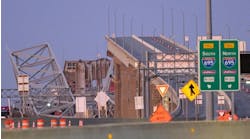By D. David Moses and Dan Filice, Contributing Authors
The Burlington Northern Santa Fe Railway Bridge — a vital structure for one of the busiest railway systems in the Chicago area — needed to accommodate the widening and reconstruction of the Illinois Tollway’s Tri-State Tollway.
The bridge carries a stream of Metra, Amtrak and freight trains over a stretch of interstate that sees 200,000 vehicles a day.
The project team consisted of Gannett Fleming, AECOM, TranSystems, HR Green, and Walsh Construction.
The team faced challenges of managing a large-scale project, where the design and construction operated within constrained spaces, while also minimizing disruption and maintaining a safe passageway for the Illinois Tollway and BNSF Railway.
Through a study, the team devised a phased approach. This ensured coordination among stakeholders, including the Illinois Department of Transportation, Metra, and local communities.
A three-track shoofly was required to maintain train traffic on a temporary alignment, creating a work zone area for replacement of the bridge. A shorter temporary bridge was designed to carry two shoofly tracks over Interstate-294, while the permanent bridge incorporated the third track.
By opting for shorter-span shoofly bridges, the project reduced the need for extensive substructure materials, leveraging lighter loads for a more sustainable construction approach.
The innovative use of steel sheet piling, U-shaped bin walls and recyclable braces and ties exemplified a commitment to environmental stewardship. It allowed materials like embankment fill to be reused.
Incorporating a permanent track bay within the temporary three-track shoofly minimized future removal efforts, aligning with the BNSF Railway’s requirements. It also demonstrated a dedication to resourcefulness and sustainability.
Other design elements included self-propelled modular transporters (SPMTs) to lift and maneuver completed portions of the bridge into place over the roadway.
Site access constraints and busy railway traffic required the design team to consider constructability in the design. For the permanent bridge, a top-down construction approach featured tightly spaced drilled shafts to support the concrete abutment cap. These were later faced with concrete to retain the earth embankment — similar to a soldier-pile retaining wall installation technique.
This abutment type was used instead of the alternative conventional highwall abutment, reducing the cost and schedule.
This technique proved effective as it minimized the contractor’s operations due to passing trains, truncated the construction schedule and helped mitigate risk. Only shallow excavation adjacent to the tracks was required to install the abutment cap.
The BNSF Railway used specialized equipment called the track laying machine (TLM) to install the tracks. The TLM must be scheduled at least one year in advance. The team developed a detailed schedule to determine the grade-ready dates for when the railway forces would install the tracks using the TLM. An interim completion date with liquidated damages was included in the contract special provisions to ensure the site was ready as planned.
The introduction of SPMT technology, a first for the Illinois Tollway, exemplified a leap towards modernized construction methodologies. This ensured the project schedule met TLM scheduling requirements.
SPMTs enable entire superstructures to be pre-assembled alongside ongoing substructure work and then lifted into place over the roadway.
This allowed construction to progress in parallel, streamlining the process. Using roadside staging areas, the construction team conducted most work away from active traffic lanes. This setup facilitated daytime operations without disruptions while ensuring operations were carried out at ground level, significantly enhancing project safety.
To facilitate traffic flow, the team implemented a counterflow configuration, maintaining continuous north and southbound traffic on one side of the Tollway.
The SPMT technology reduced what would typically be two months of night and weekend disruptions to just a single weekend for each travel direction. The project marked the Tollway’s application of SPMT technology.
Community Collaboration
The team performed an in-depth constructability study to assess the contractor’s site access, work sequence and schedule to accommodate the Tollway and BNSF Railway.
Plan details provided site access from the roadway below. They included a series of haul roads in each quadrant to deliver materials and a series of ramps within the embankment to provide the contractor access to the elevated railroad tracks. This allowed the contractor and railroad forces to complete their work without using local roads in the adjacent communities.
The project work was phased over five stages:
- Stage 1 included construction of the shoofly embankment and bridge to the south of the existing tracks. The shoofly bridge incorporated portions of the permanent bridge.
- Stage 2 featured BNSF Railway installing the ballast, ties and tracks and transitioning train traffic onto the temporary shoofly alignment.
- Stage 3 was marked by the contractor removing the existing structure, building the remaining portions of the permanent bridge and enclosing the creek with a box culvert on the north side.
- Stage 4 involved BNSF Railway installing the ballast, ties and tracks and transitioning train traffic onto the permanent alignment.
- Stage 5 brought the final project elements together as the shoofly bridge and embankment were removed and the site restored.
The design team collaborated with the villages of Hinsdale and Western Springs, alongside the Western Springs Park District, ensuring the project met expectations while also enhancing the local landscape and community.
Efforts to seamlessly integrate the project into its surroundings involved overcoming substantial challenges related to space constraints and the proximity to BNSF right-of-way.
Transportation Expansion
The project’s success hinged on a combination of planning, innovation and community partnership.
It provided a pathway for the immediate goals of the Tollway expansion and also established a standard for future infrastructure projects.
The project’s completion was integral to the ongoing Tollway corridor project as it provided the room required to reconstruct the roadway below.
The bridge reconstruction was completed on schedule and within budget. It stands as a testament to navigating complex challenges through ingenuity, teamwork and a steadfast commitment to excellence, sustainability, and community service.
The BNSF Railway Bridge reconstruction project illustrates how innovative engineering solutions can harmoniously integrate with community needs and environmental stewardship. RB
D. David Moses is a Transit and Rail Client and Program Development Leader for Gannett Fleming, and Dan Filice is manager Gannett Fleming bridge team.



